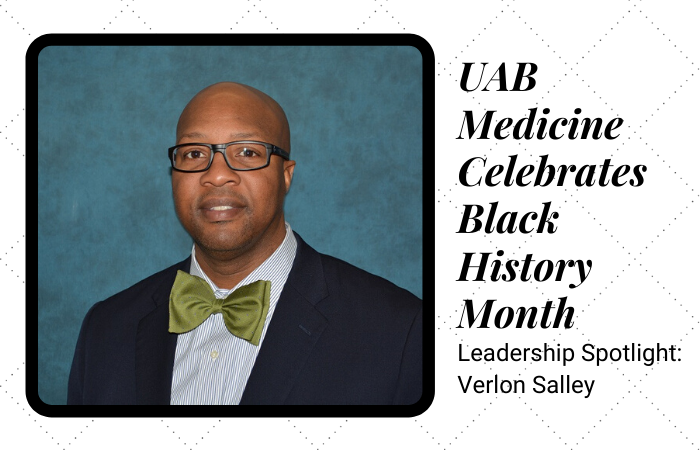Black History Month Leadership Spotlight: Verlon Salley
February 19, 2020

For Verlon Salley, UAB Medicine’s senior director of Radiology, his career in health care administration is part of a family tradition. You might even say that radiology is in his DNA.
“My mother was a patient care advocate at a hospital in Ft. Lauderdale, Florida, where I was born and raised,” Salley says. “My father was a nuclear medicine tech at a different hospital. Each summer during high school, I volunteered to work in the radiology department with my Dad, so I like to think I began learning radiology from a frontline perspective, thanks to him. My mother was in medicine for 36 years and Dad had 42 years in radiology, so a lot of what I understand about health care I gathered via osmosis from them. Both of my sisters are in hospital administration, as well.”
Salley’s proximity to the day-to-day business of health care was no guarantee that he would enter the medical field. In fact, he was almost scared away from the idea many times.
“Mom and Dad used to come home every day with something frightening or sad to share with us at dinner time,” Salley recalls. “My sisters and I called these tales ‘the hospital stories.’ We would hear about people with stab wounds, shootings, and all kinds of terrible scenes Mom had witnessed as a patient advocate at the trauma center. Dad would talk about patients with severe bone injuries or cancer. Because of those stories when we were very young, my sisters and I were pretty sure we would not be going into medicine, at any level. We got that one wrong, thankfully.”
Policies and Workflow
Salley earned a Master of Health Administration in 2002 from Virginia Commonwealth University School of Medicine. Before joining UAB Medicine in 2017, he worked in radiology operations at University of Pittsburgh Medical Center, University of Virginia Medical Center, and Sentara Healthcare.
With almost 20 years of experience in this area, Salley takes the lead role in developing, orchestrating, and implementing all enterprise-wide radiology operations initiatives at UAB Medicine. He reports to higher levels of leadership about workflow processes, presenting policy changes and the rationale for making such changes. He also works with various service lines to communicate how radiology services might complement their patient care or support some new surgical procedure or broader hospital initiative.
“Communicating our ability to drive initiatives is crucial,” Salley says. “A good example is having not just X-ray technology but also ultrasound, mammography, and other diagnostics at the new UAB Medicine Hoover clinic. We presented data that showed how often the physicians who would be at Hoover use these services and how the projected patient volume for the new clinic justified the presence of ultrasound services.”
Salley’s leadership extends beyond UAB Medicine. He is the incoming president of the Birmingham chapter of the National Association of Health Services Executives (NAHSE), after serving two years as its president-elect. A nonprofit association of black health care executives founded in 1968, NAHSE promotes the advancement and development of black health care leaders and works to elevate the quality of health care services for minority and underserved communities. UAB Medicine and NAHSE work together to address unconscious bias in health care and its impact on health disparities.
Beyond Racial Lines
It’s worth noting – especially in February during Black History Month – that black leaders in medicine have made a tremendous impact in a city that was such a battleground during the civil rights movement. However, Salley says the efforts by black leaders at UAB Medicine reach beyond racial distinctions.
“There’s a larger picture in terms of who is actually touched by health care leadership at UAB or anywhere else that you have black leaders,” Salley says. “For just two examples, we have Selwyn Vickers, dean of the UAB School of Medicine, and Tony Jones, our senior associate dean of Clinical Affairs and UAB Medicine’s first chief physician executive. Their work will ultimately reach any human being in need of better medical care, beyond any racial or demographic categories. So the point of pride for Black History Month is that black leaders are clearly impacting everyone. I think that derives from the most important aspect of medicine, which is empathy. My parents had it. They weren’t telling us those hospital stories from a racial perspective. They were talking about patients, period. If an administrator, doctor, nurse, or other team member has genuine empathy, then you can expect a great patient experience.”
